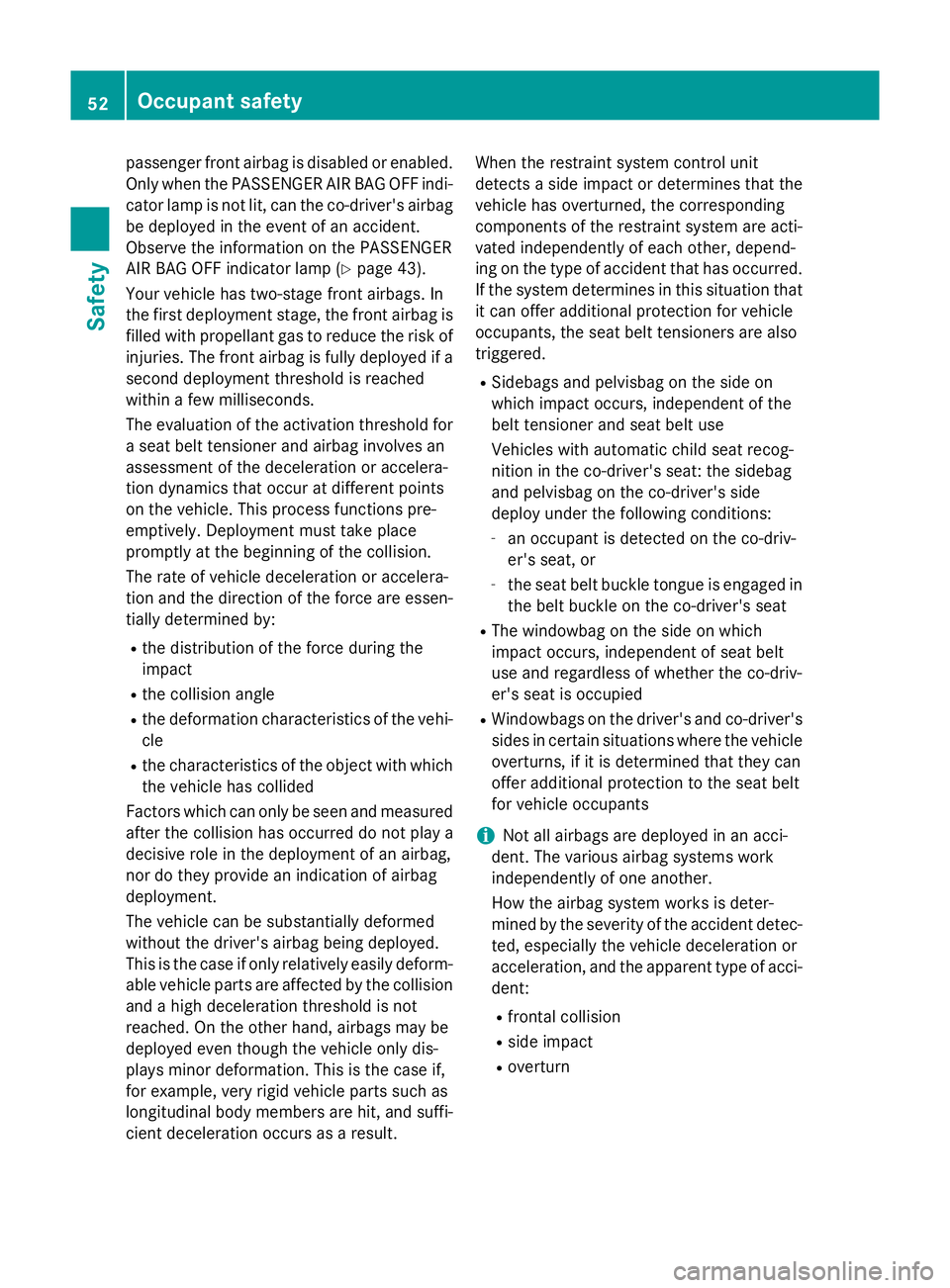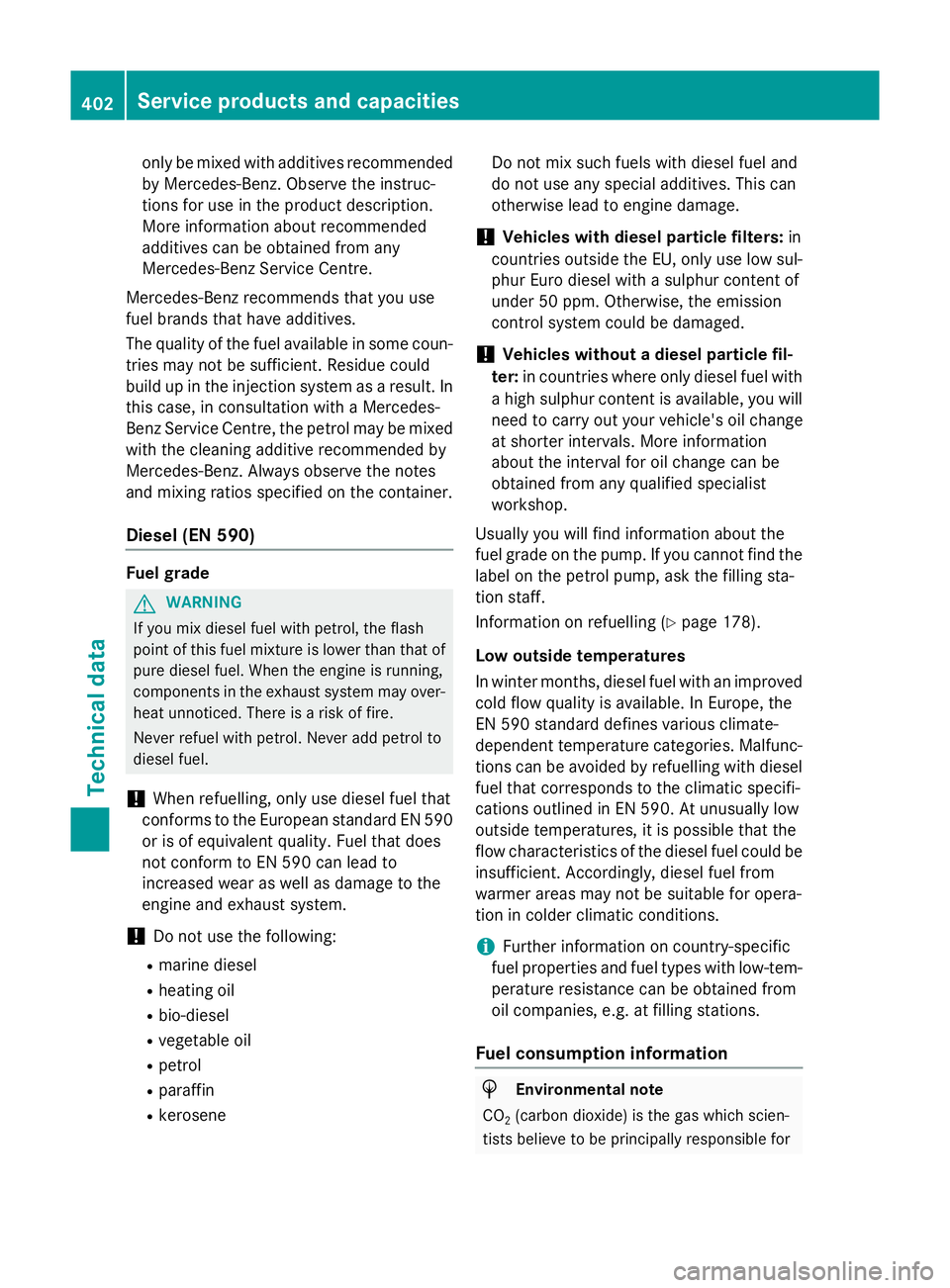2014 MERCEDES-BENZ CLS COUPE gas type
[x] Cancel search: gas typePage 55 of 417

passenger front airbag is disabled or enabled.
Only when the PASSENGER AIR BAG OFF indi-cator lamp is not lit, can the co-driver's airbag
be deployed in the event of an accident.
Observe the information on the PASSENGER
AIR BAG OFF indicator lamp (Y page 43).
Your vehicle has two-stage front airbags. In
the first deployment stage, the front airbag is filled with propellant gas to reduce the risk of
injuries. The front airbag is fully deployed if a second deployment threshold is reached
within a few milliseconds.
The evaluation of the activation threshold for
a seat belt tensioner and airbag involves an
assessment of the deceleration or accelera-
tion dynamics that occur at different points
on the vehicle. This process functions pre-
emptively. Deployment must take place
promptly at the beginning of the collision.
The rate of vehicle deceleration or accelera-
tion and the direction of the force are essen- tially determined by:
R the distribution of the force during the
impact
R the collision angle
R the deformation characteristics of the vehi-
cle
R the characteristics of the object with which
the vehicle has collided
Factors which can only be seen and measured after the collision has occurred do not play a
decisive role in the deployment of an airbag,
nor do they provide an indication of airbag
deployment.
The vehicle can be substantially deformed
without the driver's airbag being deployed.
This is the case if only relatively easily deform-
able vehicle parts are affected by the collision
and a high deceleration threshold is not
reached. On the other hand, airbags may be
deployed even though the vehicle only dis-
plays minor deformation. This is the case if,
for example, very rigid vehicle parts such as
longitudinal body members are hit, and suffi-
cient deceleration occurs as a result. When the restraint system control unit
detects a side impact or determines that the
vehicle has overturned, the corresponding
components of the restraint system are acti-
vated independently of each other, depend-
ing on the type of accident that has occurred.
If the system determines in this situation that
it can offer additional protection for vehicle
occupants, the seat belt tensioners are also
triggered.
R Sidebags and pelvisbag on the side on
which impact occurs, independent of the
belt tensioner and seat belt use
Vehicles with automatic child seat recog-
nition in the co-driver's seat: the sidebag
and pelvisbag on the co-driver's side
deploy under the following conditions:
- an occupant is detected on the co-driv-
er's seat, or
- the seat belt buckle tongue is engaged in
the belt buckle on the co-driver's seat
R The windowbag on the side on which
impact occurs, independent of seat belt
use and regardless of whether the co-driv-
er's seat is occupied
R Windowbags on the driver's and co-driver's
sides in certain situations where the vehicle
overturns, if it is determined that they can
offer additional protection to the seat belt
for vehicle occupants
i Not all airbags are deployed in an acci-
dent. The various airbag systems work
independently of one another.
How the airbag system works is deter-
mined by the severity of the accident detec- ted, especially the vehicle deceleration or
acceleration, and the apparent type of acci- dent:
R frontal collision
R side impact
R overturn 52
Occupant safetySafety
Page 405 of 417

only be mixed with additives recommended
by Mercedes-Benz. Observe the instruc-
tions for use in the product description.
More information about recommended
additives can be obtained from any
Mercedes-Benz Service Centre.
Mercedes-Benz recommends that you use
fuel brands that have additives.
The quality of the fuel available in some coun- tries may not be sufficient. Residue could
build up in the injection system as a result. In
this case, in consultation with a Mercedes-
Benz Service Centre, the petrol may be mixed with the cleaning additive recommended by
Mercedes-Benz. Always observe the notes
and mixing ratios specified on the container.
Diesel (EN 590) Fuel grade
G
WARNING
If you mix diesel fuel with petrol, the flash
point of this fuel mixture is lower than that of pure diesel fuel. When the engine is running,
components in the exhaust system may over-
heat unnoticed. There is a risk of fire.
Never refuel with petrol. Never add petrol to
diesel fuel.
! When refuelling, only use diesel fuel that
conforms to the European standard EN 590
or is of equivalent quality. Fuel that does
not conform to EN 590 can lead to
increased wear as well as damage to the
engine and exhaust system.
! Do not use the following:
R marine diesel
R heating oil
R bio-diesel
R vegetable oil
R petrol
R paraffin
R kerosene Do not mix such fuels with diesel fuel and
do not use any special additives. This can
otherwise lead to engine damage.
! Vehicles with diesel particle filters:
in
countries outside the EU, only use low sul-
phur Euro diesel with a sulphur content of
under 50 ppm. Otherwise, the emission
control system could be damaged.
! Vehicles without a diesel particle fil-
ter: in countries where only diesel fuel with
a high sulphur content is available, you will need to carry out your vehicle's oil change
at shorter intervals. More information
about the interval for oil change can be
obtained from any qualified specialist
workshop.
Usually you will find information about the
fuel grade on the pump. If you cannot find the
label on the petrol pump, ask the filling sta-
tion staff.
Information on refuelling (Y page 178).
Low outside temperatures
In winter months, diesel fuel with an improved cold flow quality is available. In Europe, the
EN 590 standard defines various climate-
dependent temperature categories. Malfunc- tions can be avoided by refuelling with diesel
fuel that corresponds to the climatic specifi-
cations outlined in EN 590. At unusually low
outside temperatures, it is possible that the
flow characteristics of the diesel fuel could be
insufficient. Accordingly, diesel fuel from
warmer areas may not be suitable for opera-
tion in colder climatic conditions.
i Further information on country-specific
fuel properties and fuel types with low-tem-
perature resistance can be obtained from
oil companies, e.g. at filling stations.
Fuel consumption information H
Environmental note
CO 2(carbon dioxide) is the gas which scien-
tists believe to be principally responsible for 402
Service products and capacitiesTechnical data